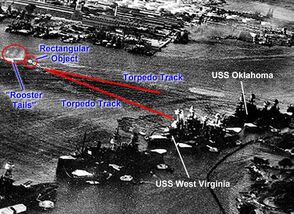m (Testing new template, replaced: {{expand}} → {{Quality|expand}}) Tag: apiedit |
Tag: Visual edit |
||
| (16 intermediate revisions by 5 users not shown) | |||
| Line 1: | Line 1: | ||
| − | {{Quality|expand}}[[File: |
+ | {{Quality|expand}}[[File:Pearl Harbor Arizona.jpg|thumb|256px|The USS ''California'' sinking into the mud. The beached ''Nevada'' is seen in the background.]] |
| − | The ''' |
+ | The '''Attack on Pearl Harbor''' was a surprise attack by the Imperial Japanese Navy against the U.S. Pacific Fleet at the Pearl Harbor Naval Base on Oahu, Hawaii on December 7, 1941. It led to the declaration of war against Japan by the [[United States]] and brought them into [[World War II]]. Before the attack, most Americans felt strongly that the United States should not get involved in a foreign war. |
==Overview== |
==Overview== |
||
| − | Pearl Harbor was attacked by 353 Japanese fighters, bombers and torpedo planes. [[Japan]] had planned this attack for a year and a half, with the aircraft crews training for fourteen hours a day. The first wave of the attack arrived on December |
+ | Pearl Harbor was attacked by 353 Japanese fighters, bombers and torpedo planes. [[Japan]] had planned this attack for a year and a half, with the aircraft crews training for fourteen hours a day. The first wave of the attack arrived on December 7, 1941 at about 7:49 AM, Hawaiian time. The first bombs were dropped on Wheeler and Ford Island at 7:55 a.m. |
| − | The plan of attack incorporated |
+ | The plan of attack incorporated lessons learned from study of the Fleet Air Arm attack against the Italian fleet at Taranto in November 1940.<ref name="WAIF F108 S03">{{WAIF}} File 108 Sheet 3: World Military Aircraft; Fairey Swordfish - Briefing.</ref> |
| + | ===The first wave<nowiki/>=== |
||
| − | [[File:Pearl_harbor_attack.jpg|thumb|left|178px|Pearl Harbor under attack]] |
||
| + | [[File:Pearl harbor attack.jpg|thumb|left|178px|Battleship Row, the burning ''West Virginia'' settles into the mud next to the ''Tennessee'']] |
||
| ⚫ | |||
| + | The war declaration was supposed to come half an hour before the attack, but communications were slow, and arrived after attack on Pearl Harbor. The Japanese would attack in two waves with the first wave, numbering 183 aircraft, attacked at 7:48 am local time. The attack waves were separated into 3 groups each with their own targets. The groups for wave one are as follows; Group 1 was ordered to attack battleship row and aircraft carriers and consisted of 48 B5N "Kate" bombers, armed with 800 kg armor piercing bombs, and 40 B5N's armed with type 91 torpedoes. Group 2 was tasked with attacking the ford island, focusing on the wheeler field airbase. This group consisted of 51 D3A "Val" bombers armed with 249 kg general purpose bombs. Group 3 was ordered to maintain air control for the mission by attacking aircraft on the ground. This group was made up of 43 A6M "zero" fighters and were equip for to make strafing runs. |
||
| + | |||
| + | The slow vulnerable "Kate" bombers led the way, exploiting the surprise, to launch torpedo attacks on the anchored battleships while "Val" dive bombers attacked the airfields and battleships. The wave commander, Mitsuo Fuchida, sounding the battle cry "Tora Tora Tora". Of the 49 bombs dropped only 8 hit their intended targets while 13 of the 40 torpedoes hit their mark. US sailors aboard the ships were woken by the sounds of explosions and gunfire. For the Americans the first wave was a time of confusion and, in some cases, panic as they struggled to bring effective fire to bear on their attackers. At 8:10 am the USS Oklahoma capsized and sank. Shortly after an Armour piercing bomb penetrated near the number 2 turret on The USS Arizona detonating the forward magazine. The first wave left around 8:30 am. |
||
| + | [[File:Pearlharborcolork13513.jpg|thumb|267x267px|The USS Arizona exploding at pearl harbor]] |
||
| + | |||
| + | === Second wave === |
||
| + | The Second wave arrived over the harbor at around 9:00 am and immediately attacked. the composition of the second wave was; Group 1 54 B5N bombers armed with 249 and 60 kg bombs attacked the hangers of the air fields, Group 2 comprising of 78 D3A's aimed to attack the carriers and cruisers while Group 3, made up of 35 A6M's were on air superiority tasks. The half hour gap however had allowed the US ships to orgonise and began to increase the Flack that was being put up. Most of the Japanese planes attacked the USS Nevada that had been able to get under way however they were unable to sink her before she ran herself aground. The majority of Japanese casualties came from the second wave which departed from Pearl harbor at around 9:45 am |
||
| + | |||
| + | === Mini sub attacks? === |
||
| + | Historians have debated for years whether or not the Japanese successfully used midget submarines during their attack. There is very little hard evidence to suggest that any of the submarines made it into an attack position. On the morning of 7 December the I-68 and I-69 took up positions to rescue midget submarine crews returning from the harbor. The 5 mini subs them selves were transported to a spot 5–13 miles SSW of the harbors entrance by I-16, I-22, I-18, I-20 and I-24. These were then released individually between 00:42 hours and 03:33 hours. |
||
| + | |||
| + | M-22 |
||
| + | |||
| + | At 04:08 hours M-22 is sighted by an American destroyer the USS Ward and is sunk. The Ward sends a message to Navel HQ in Hawaii at 06:51 saying: <blockquote>"We have attacked fired upon and dropped depth charges upon submarine operating in defensive sea area" </blockquote>Despite this no alarm is raised in Pearl harbor. |
||
| + | |||
| + | HA-19 |
||
| + | [[File:Midget3.jpg|thumb|300x300px|HA-19 after it ran aground for the final time]] |
||
| + | At 07:00 HA-19 makes the harbor entrance but is unable to gain access before the air attack commences. At around 08:00 the HA-19 hits a reef and damages her gyroscope forcing the commander to use his periscope to navigate. The USS Helm spots the mini sub at 08:17 fires and misses however HA-19's lower torpedo tube, wire cutter and vertical rudder are damaged. The HA-19's batteries then emit chlorine gas knocking the crew unconscious. After the crew regain control she runs aground again and after freeing her the crew find she is unresponsive. Drifting the HA-19 is depth charged and her crew attempt to beach her only to run aground again. Kazuo Sakamaki then lights the scuttling charges and abandons ship being battered unconscious by the surf. HA-19 fails to explode and is discovered relatively intact. |
||
| + | |||
| + | ? |
||
| + | |||
| + | At 08:30 several ships make a break for open water to evade the air attacks. The USS Zane reports: <blockquote><strong>"sighted enemy submarine 200 yards astern of MEDUSA."</strong></blockquote>The sea plane tender then opens fire at the sub. At 08:37 the USS Monaghan spots the sub again and attempts to ram her while the Medusa and Tangier open fire. The submarine fires at the Curtiss but is hit by 5 inch shell fire probably decapitating her skipper. As Monaghan closes the distance the sub turns and fires her final torpedo at her attacker but misses. Monaghan rams the sub pushing her to the bottom of the harbor then drops 2 depth charges blowing her back to the surface. The midget sub sinks NW of Ford island. |
||
| + | |||
| + | M-18 |
||
| + | |||
| + | A midget submarine believed to be M-18 <strong>i</strong>s depth charged and sinks in the Keehi Lagoon just off Pearl Harbor. |
||
| + | |||
| + | The fate of the final midget submarine is unknown however I-16 receives a radio message at 22:41 saying: <blockquote><strong>"Se, se, se!”</strong> </blockquote>However it is believed to be in relation to the air attack not the submarine attack even though it was sent from one of the submarines. At 00:51, on the 8th of December, I-16 receives a second message thought to come from M-18 saying:<blockquote><strong>"unable to navigate."</strong> </blockquote>None of the Midget subs returned from their attack on the harbor.[[File:Japanese-torpedo-hit.jpg|thumb|338x338px|Original photograph showing the roaster tails and torpedo trails]]Possible evidence for a successful sub attack comes in the form of a photograph taken of the raid. In the photo two torpedo trails can be seen heading for the USS Oklahoma and the USS West Virginia but there are no aircraft near by that could have dropped them. More over the there are what appear to be "roaster tails", a ploom of water caused by the stern of the vessel when the small submarines fired their torpedoes as bow suddenly got 2 tons lighter, at the source of the trials. This has led many to believe that this is the missing submarine. |
||
| + | [[File:Battleship-row2.jpg|thumb|294x294px|Photo highlighting the roaster tails and torpedo tracks|centre]] |
||
| + | |||
| + | === Aftermath === |
||
| + | After the attack was over, about 2,403 US servicemen were killed, (around half of which were from the destruction of the USS Arizona, 1,177) and 188 US Aircraft was destroyed, along with 53 civilians and about 64 Japanese servicemen, as well as one Japanese sailor, a midget submariner named Kazuo Sakamaki of HA-19, was taken as the first prisoner of war. The attacked targets were USS California, USS Maryland, USS Oklahoma, USS West Virginia, USS Arizona, USS Tennessee, USS Nevada, USS Pennsylvania, Ford Island NAS, and the air fields around Oahu. |
||
| + | |||
| ⚫ | After the attack was over, about 2,403 [[US]] servicemen were killed, (around half of which were from the destruction of the [[USS Arizona|USS ''Arizona'']], 1,177) and 188 US Aircraft was destroyed, along with 53 civilians and about 64 [[Japan]]ese servicemen, as well as one Japanese sailor, a midget submariner named Kazuo Sakamaki, was taken as the first prisoner of war. The attacked targets were USS ''California'', USS ''Maryland'', USS ''Oklahoma'', USS ''West Virginia'', USS ''Arizona'', USS ''Tennessee'', USS ''Nevada'', USS ''Pennsylvania'', Ford Island NAS, and the air fields around Oahu. |
||
[[File:Pearl Harbor Attack Plan.jpg|thumb|right|232px|A map of the ships in the harbor.]] |
[[File:Pearl Harbor Attack Plan.jpg|thumb|right|232px|A map of the ships in the harbor.]] |
||
Planning the attack was [[Isoroku Yamamoto]]. The original plan was to involve the destruction of the US Aircraft Carrier fleet, which he believed the destruction of would greatly lower the US's ability to wage war. He realized that the axis powers could not win a long, drawn out war. Luckily for the Americans their Carrier fleet was out on a drill leaving them undamaged from the attack. This combined with the fact that the aviation fuel tanks and dry docks remained undamaged allowed the US to wage war in only six months instead of the predicted two years in which the Japanese hoped to significantly advance. |
Planning the attack was [[Isoroku Yamamoto]]. The original plan was to involve the destruction of the US Aircraft Carrier fleet, which he believed the destruction of would greatly lower the US's ability to wage war. He realized that the axis powers could not win a long, drawn out war. Luckily for the Americans their Carrier fleet was out on a drill leaving them undamaged from the attack. This combined with the fact that the aviation fuel tanks and dry docks remained undamaged allowed the US to wage war in only six months instead of the predicted two years in which the Japanese hoped to significantly advance. |
||
| − | [[File:PearlHarbour.jpg|thumb| |
+ | [[File:PearlHarbour.jpg|thumb|right|350px|The ''Oglala'' (right) has capsized after being towed away from the ''Helena'' (left) while the ''Shaw'' (drydock) burns and the ''Nevada'' (far right) makes her run for the sea.]] |
| − | ==Lead-up== |
||
| − | The United States knew that they had treated the Japanese poorly and knew an attack was coming. In 1850, the US took an ironclad vessel over to the Japanese Islands and forced them to unfairly trade by means of 'gunboat diplomacy'. The Japanese weren't as technologically advanced and so, seeing what they were just threatened with, had to advance their technology, and quick. First, they went to get resources from [[China]]. But, although every other country had taken a chunk out of China, Japan wasn't allowed to because the Americans, along with everyone else, forbade it. Then the US froze all Japanese assets that were in American banks. But even so, the Japanese manage to upgrade their technology enough to defeat the Russians and French before World War I and attack the Americans in World War II. |
||
==Commanders== |
==Commanders== |
||
'''United States ''' |
'''United States ''' |
||
| − | *[[Admiral Husband Kimmel]] |
+ | *[[Admiral]] [[Husband Kimmel]] |
| − | *<span style="line-height:21px;">Admiral Walter Short</span> |
+ | *<span style="line-height:21px;">Admiral [[Walter Short]]</span> |
| − | *<span style="line-height:21px;">Rear Admiral Isaac Kidd (Died on-board USS Arizona |
+ | *<span style="line-height:21px;">Rear Admiral [[Isaac Kidd]] (Died on-board USS ''Arizona'')</span><ref>http://www.worldwar2facts.org/pearl-harbor-attack.html</ref> |
'''Japan''' |
'''Japan''' |
||
| Line 30: | Line 62: | ||
'''United States''' |
'''United States''' |
||
*8 battleships |
*8 battleships |
||
| + | **Battleship Division 1 |
||
| + | ***[[USS Arizona (BB-39)|USS ''Arizona'' BB-39]] |
||
| + | ***[[USS Nevada (BB-36)|USS ''Nevada'' BB-36]] |
||
| + | ***[[USS Oklahoma (BB-37)|USS ''Oklahoma'' BB-37]] |
||
| + | **Battleship Division 2 |
||
| + | ***[[USS Pennsylvania (BB-38)|USS ''Pennsylvania'' BB-38]] |
||
| + | ***[[USS Tennessee (BB-43)|USS ''Tennessee'' BB-43]] |
||
| + | ***[[USS California (BB-44)|USS ''California'' BB-44]] |
||
| + | **Battleship Division 4 |
||
| + | ***[[USS Maryland (BB-46)|USS ''Maryland'' BB-46]] |
||
| + | ***[[USS West Virginia (BB-48)|USS ''West Virginia'' BB-48]] |
||
| + | ***[[USS Colorado (BB-45)|USS ''Colorado'' BB-45]] |
||
*8 cruisers |
*8 cruisers |
||
| + | **Cruiser Division 6 (Partial) |
||
| + | ***[[USS New Orleans (CA-32)|USS ''New Orleans'' CA-32]] |
||
| + | ***[[USS San Francisco (CA-38)|USS ''San Francisco'' CA-38]] |
||
| + | **Cruiser Division 9 |
||
| + | ***[[USS Phoenix (CL-46)|USS ''Phoenix'' CL-46]] |
||
| + | ***[[USS Honolulu (CL-48)|USS ''Honolulu'' CL-48]] |
||
| + | ***[[USS St. Louis (CL-49)|USS ''St. Louis'' CL-49]] |
||
| + | ***[[USS Helena (CL-50)|USS ''Helena'' CL-50]] |
||
*30 destroyers |
*30 destroyers |
||
| + | **Destroyer Flotilla 1 |
||
| + | ***[[USS Raleigh (CL-7)|USS ''Raleigh'' CL-7]] |
||
| + | **Destroyer Squadron 1 |
||
| + | ***[[USS Phelps (DD-360)|USS ''Phelps'' DD-360]] |
||
| + | **Destroyer Division 1 |
||
| + | ***[[USS Dewey (DD-349)|USS ''Dewey'' DD-349]] |
||
| + | ***[[USS Hull (DD-350)|USS ''Hull'' DD-350]] |
||
| + | ***[[USS Macdonough (DD-351)|USS ''Macdonough'' DD-351]] |
||
| + | ***[[USS Worden (DD-352)|USS ''Worden'' DD-352]] |
||
| + | **Destroyer Division 2 |
||
| + | ***[[USS Farragut (DD-348)|USS ''Farragut'' DD-348]] |
||
| + | ***[[USS Dale (DD-353)|USS ''Dale'' DD-353]] |
||
| + | ***[[USS Monaghan (DD-354)|USS ''Monaghan'' DD-354]] |
||
| + | ***[[USS Aylwin (DD-355)|USS ''Aylwin'' DD-355]] |
||
*4 submarines |
*4 submarines |
||
*49 other ships |
*49 other ships |
||
| Line 44: | Line 110: | ||
*23 fleet submarines |
*23 fleet submarines |
||
*5 midget submarines |
*5 midget submarines |
||
| − | *414 aircraft<ref>http://www.history.com/topics/pearl-harbor |
+ | *414 aircraft<ref>http://www.history.com/topics/pearl-harbor</ref> |
==Losses and Casualties from the Battle== |
==Losses and Casualties from the Battle== |
||
'''United States''' |
'''United States''' |
||
| Line 64: | Line 130: | ||
*29 aircraft destroyed |
*29 aircraft destroyed |
||
*64 killed |
*64 killed |
||
| − | *1 captured<ref>http://www.history.army.mil/books/wwii/Guard-US/ch7.htm |
+ | *1 captured<ref>http://www.history.army.mil/books/wwii/Guard-US/ch7.htm</ref> |
==After the Attack== |
==After the Attack== |
||
| − | Following the Attack, United States President Franklin D Roosevelt asked congress for permission to declare war on Japan<ref>http://www.worldwar2facts.org/united-states-declaration-of-war-upon-japan.html |
+ | Following the Attack, United States President Franklin D Roosevelt asked congress for permission to declare war on Japan.<ref>http://www.worldwar2facts.org/united-states-declaration-of-war-upon-japan.html</ref> Congress declared war on Japan on December 8, 1941. This led to the deployment of [[Martin B-26 Marauder]] bombers to [[Australia]] the day after the attack.<ref name="World Bomber Encyclopedia p130">{{World Bomber Encyclopedia}} Page 130</ref> Meanwhile, on December 11, 1941, Nazi Germany and Italy declared War on the United States. The United States was then at war with all three members of the Axis Powers and had officially entered World War II.[[File:220px-Bundesarchiv Bild 183-1987-0703-507, Berlin, Reichstagssitzung, Rede Adolf Hitler.jpg|thumb|Adolf Hitler, leader of Nazi Germany, declares war on the United States on December 11th, 1941]] |
==References== |
==References== |
||
| Line 73: | Line 139: | ||
[[Category:Raids]] |
[[Category:Raids]] |
||
[[Category:1941]] |
[[Category:1941]] |
||
| + | {{Battles in the Pacific}} |
||
Revision as of 01:32, 27 October 2018
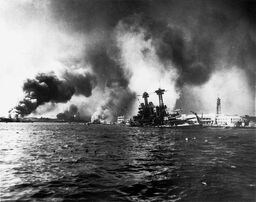
The USS California sinking into the mud. The beached Nevada is seen in the background.
The Attack on Pearl Harbor was a surprise attack by the Imperial Japanese Navy against the U.S. Pacific Fleet at the Pearl Harbor Naval Base on Oahu, Hawaii on December 7, 1941. It led to the declaration of war against Japan by the United States and brought them into World War II. Before the attack, most Americans felt strongly that the United States should not get involved in a foreign war.
Overview
Pearl Harbor was attacked by 353 Japanese fighters, bombers and torpedo planes. Japan had planned this attack for a year and a half, with the aircraft crews training for fourteen hours a day. The first wave of the attack arrived on December 7, 1941 at about 7:49 AM, Hawaiian time. The first bombs were dropped on Wheeler and Ford Island at 7:55 a.m.
The plan of attack incorporated lessons learned from study of the Fleet Air Arm attack against the Italian fleet at Taranto in November 1940.[1]
The first wave
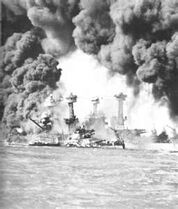
Battleship Row, the burning West Virginia settles into the mud next to the Tennessee
The war declaration was supposed to come half an hour before the attack, but communications were slow, and arrived after attack on Pearl Harbor. The Japanese would attack in two waves with the first wave, numbering 183 aircraft, attacked at 7:48 am local time. The attack waves were separated into 3 groups each with their own targets. The groups for wave one are as follows; Group 1 was ordered to attack battleship row and aircraft carriers and consisted of 48 B5N "Kate" bombers, armed with 800 kg armor piercing bombs, and 40 B5N's armed with type 91 torpedoes. Group 2 was tasked with attacking the ford island, focusing on the wheeler field airbase. This group consisted of 51 D3A "Val" bombers armed with 249 kg general purpose bombs. Group 3 was ordered to maintain air control for the mission by attacking aircraft on the ground. This group was made up of 43 A6M "zero" fighters and were equip for to make strafing runs.
The slow vulnerable "Kate" bombers led the way, exploiting the surprise, to launch torpedo attacks on the anchored battleships while "Val" dive bombers attacked the airfields and battleships. The wave commander, Mitsuo Fuchida, sounding the battle cry "Tora Tora Tora". Of the 49 bombs dropped only 8 hit their intended targets while 13 of the 40 torpedoes hit their mark. US sailors aboard the ships were woken by the sounds of explosions and gunfire. For the Americans the first wave was a time of confusion and, in some cases, panic as they struggled to bring effective fire to bear on their attackers. At 8:10 am the USS Oklahoma capsized and sank. Shortly after an Armour piercing bomb penetrated near the number 2 turret on The USS Arizona detonating the forward magazine. The first wave left around 8:30 am.
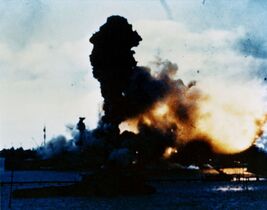
The USS Arizona exploding at pearl harbor
Second wave
The Second wave arrived over the harbor at around 9:00 am and immediately attacked. the composition of the second wave was; Group 1 54 B5N bombers armed with 249 and 60 kg bombs attacked the hangers of the air fields, Group 2 comprising of 78 D3A's aimed to attack the carriers and cruisers while Group 3, made up of 35 A6M's were on air superiority tasks. The half hour gap however had allowed the US ships to orgonise and began to increase the Flack that was being put up. Most of the Japanese planes attacked the USS Nevada that had been able to get under way however they were unable to sink her before she ran herself aground. The majority of Japanese casualties came from the second wave which departed from Pearl harbor at around 9:45 am
Mini sub attacks?
Historians have debated for years whether or not the Japanese successfully used midget submarines during their attack. There is very little hard evidence to suggest that any of the submarines made it into an attack position. On the morning of 7 December the I-68 and I-69 took up positions to rescue midget submarine crews returning from the harbor. The 5 mini subs them selves were transported to a spot 5–13 miles SSW of the harbors entrance by I-16, I-22, I-18, I-20 and I-24. These were then released individually between 00:42 hours and 03:33 hours.
M-22
At 04:08 hours M-22 is sighted by an American destroyer the USS Ward and is sunk. The Ward sends a message to Navel HQ in Hawaii at 06:51 saying:
"We have attacked fired upon and dropped depth charges upon submarine operating in defensive sea area"
Despite this no alarm is raised in Pearl harbor.
HA-19
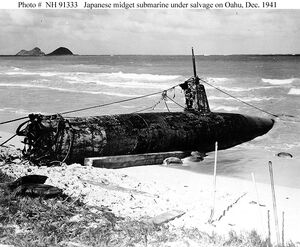
HA-19 after it ran aground for the final time
At 07:00 HA-19 makes the harbor entrance but is unable to gain access before the air attack commences. At around 08:00 the HA-19 hits a reef and damages her gyroscope forcing the commander to use his periscope to navigate. The USS Helm spots the mini sub at 08:17 fires and misses however HA-19's lower torpedo tube, wire cutter and vertical rudder are damaged. The HA-19's batteries then emit chlorine gas knocking the crew unconscious. After the crew regain control she runs aground again and after freeing her the crew find she is unresponsive. Drifting the HA-19 is depth charged and her crew attempt to beach her only to run aground again. Kazuo Sakamaki then lights the scuttling charges and abandons ship being battered unconscious by the surf. HA-19 fails to explode and is discovered relatively intact.
?
At 08:30 several ships make a break for open water to evade the air attacks. The USS Zane reports:
"sighted enemy submarine 200 yards astern of MEDUSA."
The sea plane tender then opens fire at the sub. At 08:37 the USS Monaghan spots the sub again and attempts to ram her while the Medusa and Tangier open fire. The submarine fires at the Curtiss but is hit by 5 inch shell fire probably decapitating her skipper. As Monaghan closes the distance the sub turns and fires her final torpedo at her attacker but misses. Monaghan rams the sub pushing her to the bottom of the harbor then drops 2 depth charges blowing her back to the surface. The midget sub sinks NW of Ford island.
M-18
A midget submarine believed to be M-18 is depth charged and sinks in the Keehi Lagoon just off Pearl Harbor.
The fate of the final midget submarine is unknown however I-16 receives a radio message at 22:41 saying:
"Se, se, se!”
However it is believed to be in relation to the air attack not the submarine attack even though it was sent from one of the submarines. At 00:51, on the 8th of December, I-16 receives a second message thought to come from M-18 saying:
"unable to navigate."
None of the Midget subs returned from their attack on the harbor.
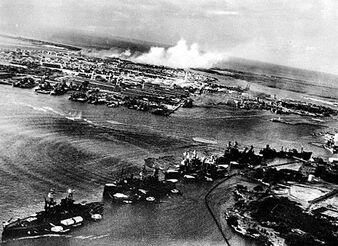
Original photograph showing the roaster tails and torpedo trails
Possible evidence for a successful sub attack comes in the form of a photograph taken of the raid. In the photo two torpedo trails can be seen heading for the USS Oklahoma and the USS West Virginia but there are no aircraft near by that could have dropped them. More over the there are what appear to be "roaster tails", a ploom of water caused by the stern of the vessel when the small submarines fired their torpedoes as bow suddenly got 2 tons lighter, at the source of the trials. This has led many to believe that this is the missing submarine.
Aftermath
After the attack was over, about 2,403 US servicemen were killed, (around half of which were from the destruction of the USS Arizona, 1,177) and 188 US Aircraft was destroyed, along with 53 civilians and about 64 Japanese servicemen, as well as one Japanese sailor, a midget submariner named Kazuo Sakamaki of HA-19, was taken as the first prisoner of war. The attacked targets were USS California, USS Maryland, USS Oklahoma, USS West Virginia, USS Arizona, USS Tennessee, USS Nevada, USS Pennsylvania, Ford Island NAS, and the air fields around Oahu.
After the attack was over, about 2,403 US servicemen were killed, (around half of which were from the destruction of the USS Arizona, 1,177) and 188 US Aircraft was destroyed, along with 53 civilians and about 64 Japanese servicemen, as well as one Japanese sailor, a midget submariner named Kazuo Sakamaki, was taken as the first prisoner of war. The attacked targets were USS California, USS Maryland, USS Oklahoma, USS West Virginia, USS Arizona, USS Tennessee, USS Nevada, USS Pennsylvania, Ford Island NAS, and the air fields around Oahu.
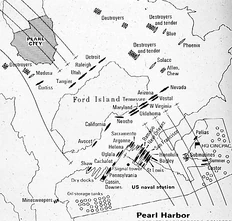
A map of the ships in the harbor.
Planning the attack was Isoroku Yamamoto. The original plan was to involve the destruction of the US Aircraft Carrier fleet, which he believed the destruction of would greatly lower the US's ability to wage war. He realized that the axis powers could not win a long, drawn out war. Luckily for the Americans their Carrier fleet was out on a drill leaving them undamaged from the attack. This combined with the fact that the aviation fuel tanks and dry docks remained undamaged allowed the US to wage war in only six months instead of the predicted two years in which the Japanese hoped to significantly advance.
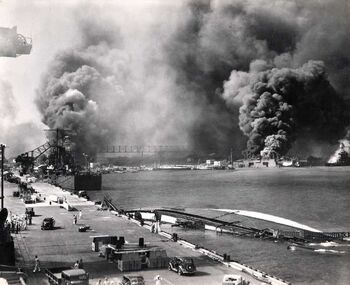
The Oglala (right) has capsized after being towed away from the Helena (left) while the Shaw (drydock) burns and the Nevada (far right) makes her run for the sea.
Commanders
United States
- Admiral Husband Kimmel
- Admiral Walter Short
- Rear Admiral Isaac Kidd (Died on-board USS Arizona)[2]
Japan
- Admiral Chuichi Nagumo
- Marshal General Isoroku Yamamoto
Order of Battle
United States
- 8 battleships
- Battleship Division 1
- USS Arizona BB-39
- USS Nevada BB-36
- USS Oklahoma BB-37
- Battleship Division 2
- USS Pennsylvania BB-38
- USS Tennessee BB-43
- USS California BB-44
- Battleship Division 4
- USS Maryland BB-46
- USS West Virginia BB-48
- USS Colorado BB-45
- Battleship Division 1
- 8 cruisers
- Cruiser Division 6 (Partial)
- USS New Orleans CA-32
- USS San Francisco CA-38
- Cruiser Division 9
- USS Phoenix CL-46
- USS Honolulu CL-48
- USS St. Louis CL-49
- USS Helena CL-50
- Cruiser Division 6 (Partial)
- 30 destroyers
- Destroyer Flotilla 1
- USS Raleigh CL-7
- Destroyer Squadron 1
- USS Phelps DD-360
- Destroyer Division 1
- USS Dewey DD-349
- USS Hull DD-350
- USS Macdonough DD-351
- USS Worden DD-352
- Destroyer Division 2
- USS Farragut DD-348
- USS Dale DD-353
- USS Monaghan DD-354
- USS Aylwin DD-355
- Destroyer Flotilla 1
- 4 submarines
- 49 other ships
- ~390 aircraft
Empire of Japan
- 6 aircraft carriers
- 2 battleships
- 2 heavy cruisers
- 1 light cruiser
- 9 destroyers
- 8 tankers
- 23 fleet submarines
- 5 midget submarines
- 414 aircraft[3]
Losses and Casualties from the Battle
United States
- 4 battleships sunk
- 3 battleships damaged
- 1 battleship grounded
- 2 destroyers sunk
- 1 other ship sunk
- 3 cruisers damaged
- 1 destroyer damaged
- 3 other ships damaged
- 188 aircraft destroyed
- 155 aircraft damaged
- 2,402 killed
- 1,247 wounded
Empire of Japan
- 4 midget submarines sunk
- 1 midget submarine grounded
- 29 aircraft destroyed
- 64 killed
- 1 captured[4]
After the Attack
Following the Attack, United States President Franklin D Roosevelt asked congress for permission to declare war on Japan.[5] Congress declared war on Japan on December 8, 1941. This led to the deployment of Martin B-26 Marauder bombers to Australia the day after the attack.[6] Meanwhile, on December 11, 1941, Nazi Germany and Italy declared War on the United States. The United States was then at war with all three members of the Axis Powers and had officially entered World War II.
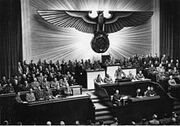
Adolf Hitler, leader of Nazi Germany, declares war on the United States on December 11th, 1941
References
- ↑ World Aircraft Information Files Aviation Partwork. Midsummer Books Ltd. File 108 Sheet 3: World Military Aircraft; Fairey Swordfish - Briefing.
- ↑ http://www.worldwar2facts.org/pearl-harbor-attack.html
- ↑ http://www.history.com/topics/pearl-harbor
- ↑ http://www.history.army.mil/books/wwii/Guard-US/ch7.htm
- ↑ http://www.worldwar2facts.org/united-states-declaration-of-war-upon-japan.html
- ↑ Crosby, Francis. The World Encyclopedia of Bombers.
Anness Publishing Ltd. (2013) ISBN 1 78019 205 3 Page 130
| |||||||||||||||||

